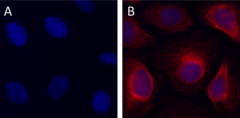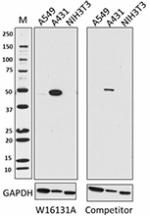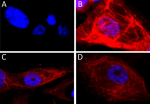- Clone
- W16131A (See other available formats)
- Regulatory Status
- RUO
- Other Names
- Keratin, type I cytoskeletal 17, keratin-17 (K-17), cytokeratin-17 (CK-17), KRT17, CK17, K17
- Isotype
- Rat IgG2b, κ
- Ave. Rating
- Submit a Review
- Product Citations
- publications

-

HeLa cells were fixed with 4% paraformaldehyde for 10 minutes, permeabilized with Triton X-100 for 10 minutes, and blocked with 5% FBS for 60 minutes. Cells were then intracellularly stained with a 1:1000 dilution (0.5 µg/mL) of either Alexa Fluor® 647 Rat IgG2b, κ Isotype Ctrl Antibody (Cat. No. 400626, panel A) or Alexa Fluor® 647 anti-Cytokeratin 17 Antibody (panel B), overnight at 4°C. Nuclei were counterstained with DAPI and the image was captured with a 60X objective.
| Cat # | Size | Price | Save |
|---|---|---|---|
| 697205 | 25 µg | ¥29,920 | |
| 697206 | 100 µg | ¥73,700 |
Cytokeratin 17 (CK-17), also known as KRT17 or keratin-17 (K-17), is a type I intermediate filament protein. KRT expression is normally restricted to ectoderm-derived epithelial appendages such as thymus, glands, skin, hair, tooth, nail, and the endocervical mucosa. Cytokeratin-17 participates in promoting protein synthesis and cell growth through recruiting stratifin (SFN) to the cytoplasm and stimulating the Akt/mTOR pathway. Cytokeratin-17 was found to regulate chemokine expression, including the CXCR3 ligands CXCL9, CXCL10, and CXCL11. Cytokeratin 17 expression can be upregulated in response to chemical stimulation, wounding, and UV irradiation. Increased expression of Cytokeratin 17 is associated with lesion progression and poor prognosis in epithelial carcinoma. Cytokeratin 17 deficient mice show a delay in wound healing and attenuated tumorigenesis.
Product DetailsProduct Details
- Verified Reactivity
- Human
- Antibody Type
- Monoclonal
- Host Species
- Rat
- Immunogen
- Human Cytokeratin 17 peptide (415-432 a.a.) conjugated to KLH
- Formulation
- Phosphate-buffered solution, pH 7.2, containing 0.09% sodium azide.
- Preparation
- The antibody was purified by affinity chromatography and conjugated with Alexa Fluor® 647 under optimal conditions.
- Concentration
- 0.5 mg/mL
- Storage & Handling
- The antibody solution should be stored undiluted between 2°C and 8°C, and protected from prolonged exposure to light. Do not freeze.
- Application
-
ICC - Quality tested
- Recommended Usage
-
Each lot of this antibody is quality control tested by immunocytochemistry. For immunocytochemistry, a concentration range of 0.5 - 2.0 μg/mL is recommended. It is recommended that the reagent be titrated for optimal performance for each application.
* Alexa Fluor® 647 has a maximum emission of 668 nm when it is excited at 633 nm / 635 nm.
Alexa Fluor® and Pacific Blue™ are trademarks of Life Technologies Corporation.
View full statement regarding label licenses - Excitation Laser
-
Red Laser (633 nm)
- Application Notes
-
This clone does not cross-react with mouse (in-house tested).
As per the Human Protein Atlas RNA level dataset, A549 cell is expected to have a low level of Cytokeratin 17 expression. - RRID
-
AB_2814537 (BioLegend Cat. No. 697205)
AB_2814537 (BioLegend Cat. No. 697206)
Antigen Details
- Structure
- 432 amino acids with a predicted molecular weight of 48 kD. Belongs to the type-I intermediate filament family.
- Distribution
-
Cytoplasm
- Function
- Cytokeratin 17 is a type I intermediate filament protein and is involved in promoting cell growth, chemokine production, and tumorigenesis.
- Interaction
- Forms a heterodimer with a type I or a type II keratin. Interacts with TRADD and SFN.
- Biology Area
- Cancer Biomarkers, Cell Biology, Cell Motility/Cytoskeleton/Structure, Neuroscience, Neuroscience Cell Markers
- Molecular Family
- Intermediate Filaments
- Antigen References
-
1. Hobbs RP, et al. 2016. Oncogene. 35:5653.
2. Escobar-Hoyos LF, et al. 2015. Cancer Res. 75:3650.
3. Chung BM, et al. 2015. J. Cell. Biol. 208:613.
4. Sankar S, et al. 2013. Mol. Cell. Biol. 33:4448.
5. Jin L, et al. 2014. Med. Res. Rev. 34:438.
6. Depianto D, et al. 2010. Nat. Genet. 42:910. - Gene ID
- 3872 View all products for this Gene ID
- UniProt
- View information about Cytokeratin 17 on UniProt.org
Related Pages & Pathways
Pages
Related FAQs
Other Formats
View All Cytokeratin 17 Reagents Request Custom Conjugation| Description | Clone | Applications |
|---|---|---|
| Purified anti-Cytokeratin 17 | W16131A | WB,ICC,IHC-P |
| Alexa Fluor® 594 anti-Cytokeratin 17 | W16131A | ICC |
| Alexa Fluor® 647 anti-Cytokeratin 17 | W16131A | ICC |
| Alexa Fluor® 488 anti-Cytokeratin 17 | W16131A | ICC |
Compare Data Across All Formats
This data display is provided for general comparisons between formats.
Your actual data may vary due to variations in samples, target cells, instruments and their settings, staining conditions, and other factors.
If you need assistance with selecting the best format contact our expert technical support team.
-
Purified anti-Cytokeratin 17

Total cell lysates (15µg protein) from A549, A431 and NIH3T3... 
A431 cells were fixed with 4% paraformaldehyde (PFA) for fi... 
IHC staining using purified anti-Cytokeratin 17 (clone W1613... 
IHC staining using purified anti-Cytokeratin 17 (clone W1613... -
Alexa Fluor® 594 anti-Cytokeratin 17

A431 cells were fixed with 4% paraformaldehyde (PFA) for 10 ... -
Alexa Fluor® 647 anti-Cytokeratin 17

HeLa cells were fixed with 4% paraformaldehyde for 10 minute... -
Alexa Fluor® 488 anti-Cytokeratin 17

HeLa cells were fixed with 4% paraformaldehyde for 10 minute...












Follow Us